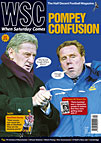 The top two teams in the Deloitte Football Money League are Real Madrid and Manchester Utd. But as Roger Titford finds out, the income they rely on differs greatly
The top two teams in the Deloitte Football Money League are Real Madrid and Manchester Utd. But as Roger Titford finds out, the income they rely on differs greatly
We live in an era when there are prizes for everything: player of the season, calendar of the year, the best pie, the most improved website and many more self-regarding baubles. Combine this with the obsession to put a value on anything in football – press red now for a cost-benefit analysis on that through ball – and we have (hopefully tongue in cheek but probably not) the Deloitte Football Money League (DFML).
Actually we have had it for nine years without really noticing, but this year it has something of a publicity coup – Real Madrid have deposed Manchester United from the top spot. United dispute this in true Fergie fashion – what about MUTV and MUMobile, they say? And this is one league table that could well lie.
The DFML is a measure of clubs’ revenue only, the accountancy equivalent of a league table that only has a “goals for” column – indicative but potentially misleading. It excludes revenue from player transfers (let’s exclude goals scored outside the box) and includes results from different time periods (we’ll count some of last season’s matches, too). It is also subject to internal adjustments, is unaudited and unverified, and contains “data” from Italy. It’s the kind of exercise that gives football a good name just for the clarity of who wins and loses. Nevertheless, the report has been an important PR tool for its authors.
Leaving behind the easy game of accountant-baiting, what can we learn about the Money League? To be fair to Deloitte, its broad-brushstrokes picture is probably as accurate as any is ever likely to be and demonstrates, for example, the current financial gulf between Manchester United and Arsenal. And things do change in the Money League. Leeds United have appeared in six of the nine top 20s released to date, along with other financial basket cases such as Sunderland and Fiorentina. Everton may be surprised to see themselves in this year at number 18.
But you have to go to the other end of the table for the really slavering language, where Real Madrid have edged ahead of Manchester United (or not). The Meringues have scored well in developing their international support (Asian tours) and the development of their three-level partner programme. (Myself, I’m less keen on “partner programmes” as they seem to have severely impacted my chances of getting World Cup tickets.) Madrid now take 45 per cent of their revenue from “commercial sources”. United, in second place, rely most on good old‑fashioned match-day income (42 per cent) while AC Milan in third spot draw their largest share (59 per cent) from “broadcast” income. It is interesting to note that each of the three biggest clubs have quite different revenue mixes and startling to learn that Juventus’s gates are about the same as Charlton’s.
“Real has shown a tremendous level of resource growth since the millennium. The challenge for the club is to press on and maintain its position at the top of the Deloitte Football Money League, and to translate this into improved levels of success on the pitch,” enthuses the summary. So congrats, Becks – it’s your first medal for Real.
From WSC 230 April 2006. What was happening this month